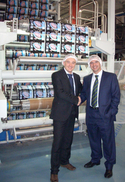Retrofit brings Turkish delight
16 September 2008Rotomec rebuild of existing gravure press boosts productivity for Bak Ambalaj
In August 2007, Turkish converter Bak Ambalaj began a rebuilding project to replace the mechanical line shaft (MLS) on a Rotomec 7-colour 3000-3 press installed in 1994 with an electronic line shaft (ES). The project, carried out by Rotomec, was the first to implement the electronic line shaft on an existing press – and to integrate it with the latest generation Registron S 5100-E4 HDI register control through the HDI (High Dynamic Interface) communication interface system.
The complete retrofit package provided Bak Ambalaj’s existing line with all the advantages of the ES and register control integration technology - “just like on a latest generation gravure line”.
“We decided on this project because of the changes in market demand,“ explains Enver Bakioglu, president of the Bakioglu Holding Packaging Group. “Customers are placing increasingly frequent orders for shorter production runs and they also request much shorter lead time than in the past. Until five years ago, our production schedule required on average two to three job change-overs a day on a gravure press; today the average is five to six and on some machines even up to eight a day.
“This means that the press must provide very fast job change-overs to avoid costly press downtimes. Furthermore, to cope with pressure from large international customers and raw materials cost increases, we must produce with the minimum possible waste. Mechanical shaft machines are not up to it: job set-up and change-over times are too long, the register correction time is too long and the level of waste too high.”
The rebuilding project carried out by Rotomec involved the removal of all the mechanical drives and installation of a new drive group on every printing unit, which was then equipped with an independent AC motor, linked to an automatic clamp for fast locking/unlocking of the gravure cylinder. ES technology eliminates the need for compensators and enables a 10-15 per cent reduction in web path length.
The retrofitted press quickly resumed production in September 2007 and Enver Bakioglu is fully satisfied with the outcome of the project.
“In view of the results achieved so far, we consider that we now have a latest generation gravure press, by comparison with the machine’s previous performance,” he enthuses. “Although the MLS press had a mechanical speed of 250 m/min, our average production speed was 140 m/min, because the register control was too slow to compensate the error at speed variations, generating too much waste on short production runs.
“Now we print at an average speed of 220 m/min and have gained around a 55 per cent increase in productivity because of the higher printing speed. Furthermore, thanks to the integration of the ES with the register control system, we are able to produce high quality printing with no waste even at speed variations. A higher production speed is only limited by the fact that the dryers installed in 1997 provide for a maximum drying speed of 250 m/min which is insufficient for drying many of today’s high ink coverage jobs.
“Our next project will be to increase the current drying capacity so as to bring the average production speed to 300m/min,” he adds.
He is also very satisfied with the productivity gains achieved, thanks to much faster job change-overs.
“A 7-colour job change-over on the MLS press took on average 80 minutes to complete. Our presses run on a three shifts 24/24 and six change-overs a day on average meant nine hours lost in press downtime just for job changes, plus the time needed for colour matching. Today, we are able to perform a 7-colour job change-over in 29 minutes plus colour matching, which considerably increases the press run time per day.”
Additional savings are said to come from the lower energy consumption that Enver Bakioglu has been able to calculate precisely with the data system linked to the press at 25 per cent less - as well as in the reduced machine maintenance cost due to the absence of gearboxes and other mechanical parts.
“The performance of the ES press has clearly shown that it brings major time and money saving immediately after the retrofitting, and a fast return on the investment. In the light of our experience we will implement a new investment plan to convert all our existing MLS presses to ES technology by mid-2010,” he concludes.
Enver Bakioglu (right) and Alberto Giannotti, Rotomec Rebuilding sales manager, with the retrofitted press Retrofitted press Related ArticlesLook before you take the leapExternal weblinksConverting Today is not responsible for the content of external internet sites.Rotomec


